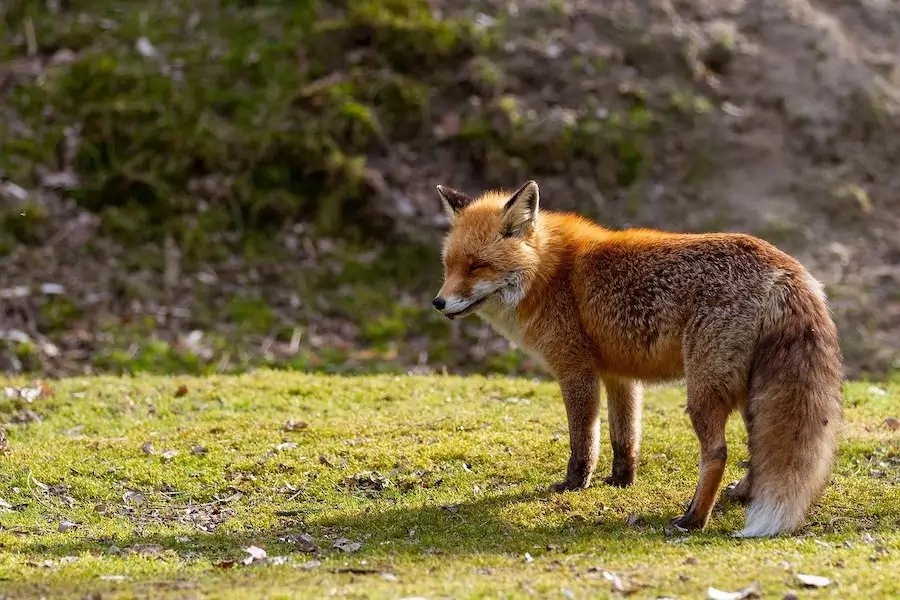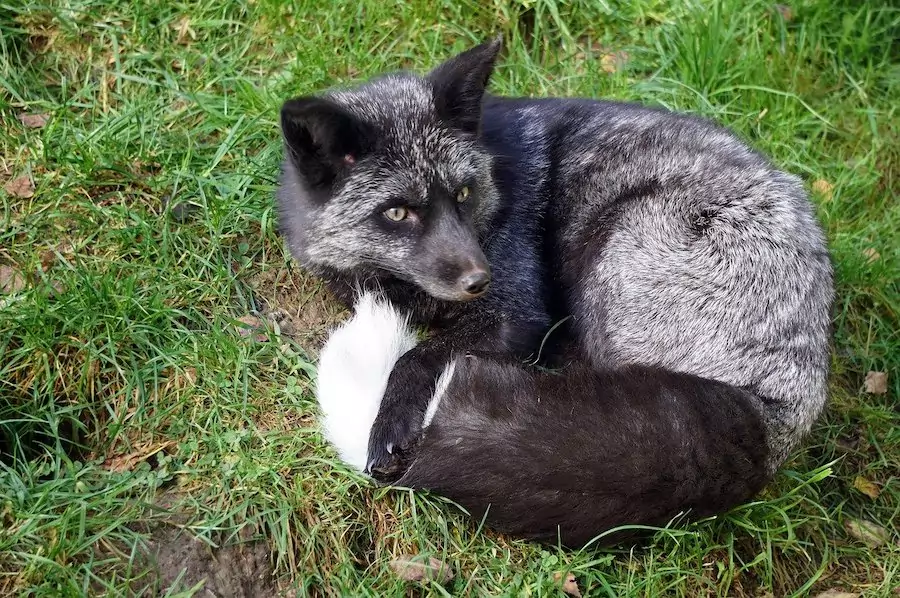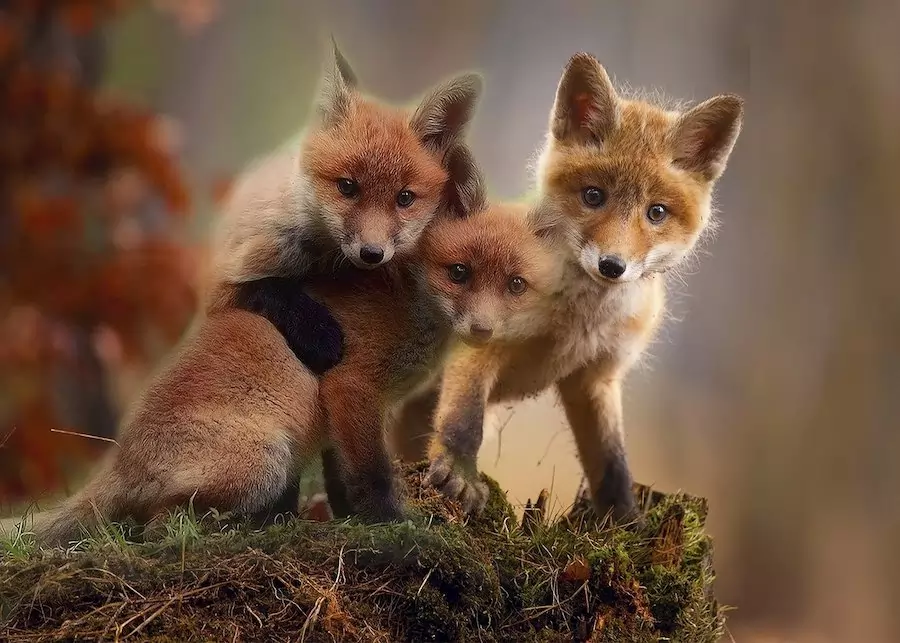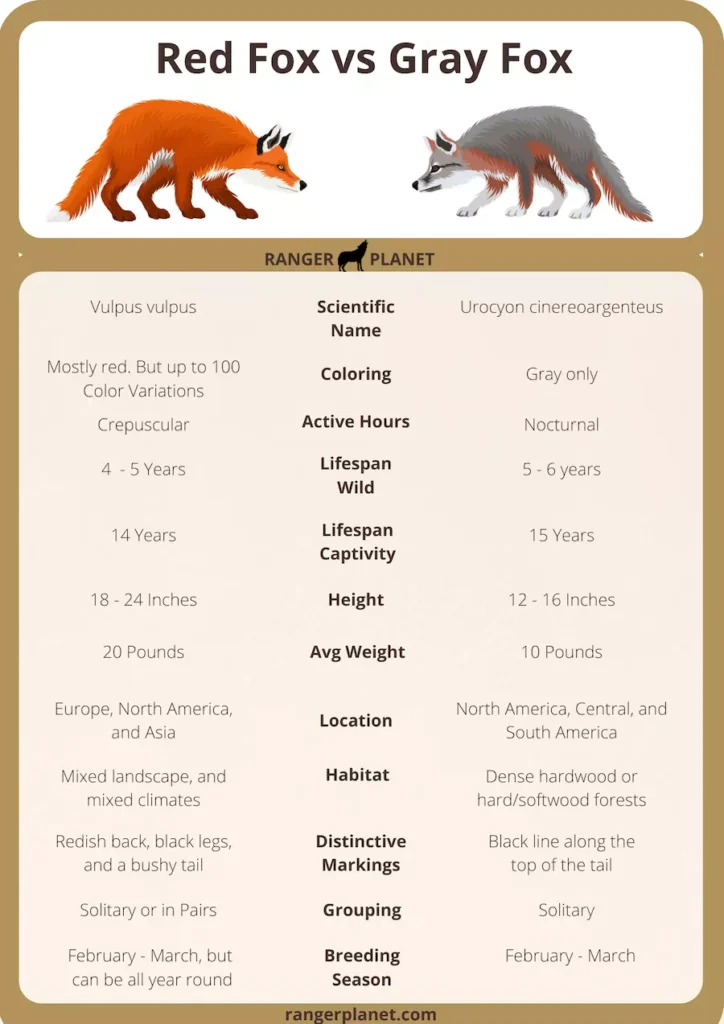There are several red fox subspecies and at least one gray fox subspecies. Let’s take a closer look at the red fox vs gray fox to see how they’re similar, how they differ, their behavior, habitat, hunting, mating, red fox pups vs gray fox pups, and more.
Here’s the quick takeaway answer to the red fox vs gray fox, then we’ll get into more detail.
Red foxes have the most color variation and tend to be larger than gray foxes. Habitats are similar but gray foxes prefer forest areas. Red foxes have black legs, a white tail tip, while the gray fox has a black back stripe down its tail. Their diets, behavior, and main predators are also similar.
That’s a quick rundown, but to get into more details, let’s start off with the general description of each, then we’ll go through other differentiating aspects.
Red Fox vs Gray fox: General Description
Gray foxes and red foxes share greater similarities with each other than either do with their cousin, the arctic fox.
The main feature, aside from the color, is that red and gray foxes are simply more canine in nature than the arctic fox.
You can find out more about the arctic fox here. Which are often thought to be the smartest fox breed.
Gray foxes are adapted to climbing trees and can climb trees vertically. But in comparison, they’re not quite as fast on their feet, or as agile as red foxes.
The red fox, while having very similar physical features, is larger, and is the more well-known and widespread of the two species.

Fox coloring
Red foxes Named after their reddish fur which can range from bright orange to dark brown, but the color pallet is actually wider than this.
In fact, red foxes have over 100 color variations across the species.
This can even extend through to a more silver color, which can make full identification difficult. But there are other features that usually set them apart…
For the majority of the time, the red foxes’ red coats tend to be a dark brick-red color, with the exception of their black legs, ears, and tail tip which is white.
Their white-tipped tails are black at the base, which makes it easier to distinguish them – even when they’re running.
The red coat becomes gray at the muzzle while their belly fur is almost cream-colored.
By contrast, gray foxes are always a standard short-haired gray color, they do not have color variations.
The gray fox’s tail has shorter hair that is gray on the underside and a distinct black stripe running down the back.
Gray foxes have a pale underside with dark, short fur on their back, which often makes it look two-toned. Not too dissimilar to a wolf or a coyote who are also part of the Canid family.
If a fox is running, you might also see that if the tail is held up while running then it’s most likely a gray fox.
You might also then see the unique black stripe down their tail which all gray foxes will have.

Red fox vs Gray fox: Size and Weight
In terms of height and weight, red foxes are slightly taller and heavier than gray foxes.
Gray foxes have a smaller overall build than red foxes, with adults weighing between 4 and 8 pounds. Red foxes typically grow to about 20-30 pounds in weight, slightly more than gray foxes.
For both species, the males are typically larger than the females. But there are sometimes exceptions.
| Red Fox | Gray Fox | |
|---|---|---|
| Avg. Height | 18 – 24 inches | 12 – 16 inches |
| Avg. Weight/Mass | 30 lbs | 8.5 lbs |
Red vs Gray fox: Physical Characteristics
Both red and gray foxes have the same number of teeth (42), but red foxes have longer canine teeth. This helps them rip through their prey.
The ears of a gray are much bigger than those of a red, which is an adaptation that allows them to hear their prey in the brush. Their tails also help with balance while they’re running after prey or climbing trees.
Red fox vs Gray fox: Lifespan
Red foxes live for around 4-5 years in the wild or 14 years in captivity. While gray foxes can live up to 6 years in the wild and 15 years in captivity!
Here’s an extract from the full table below showing their lifespan and also compares that with the arctic fox. For more information see the larger summary table further below.
| Red Fox | Gray Fox | |
|---|---|---|
| Lifespan in the Wild | 3-4 years | 5-6 years |
| Lifespan in Captivity | 14 years | 15 years |
Red fox vs Gray fox: Geographical Location
Both red foxes and gray foxes live throughout the Northern Hemisphere with red foxes being more predominant in Europe, North America, and Asia. And gray foxes in North America, Central, and South America.
Red foxes also inhabit Africa but do not generally live in the Southern Hemisphere
| Red Fox | Gray Fox | |
|---|---|---|
| Location | Europe, North America, and Asia | North America, Central, and South America |

Red fox vs Gray fox: Habitat
The two species also tend to reside in different habitats but Both red and gray foxes live throughout North America and Eurasia. Red foxes do not generally live in tropical or subtropical climates.
The red fox prefers open fields and grasslands, with woods nearby for hunting prey. They also like areas with low and varied vegetation where they can hide from danger.
Gray foxes prefer to live in hardwood forests or a mix of hardwood and softwood forests that provide dense foliage.
Red fox vs Gray fox: Territory
Most fox territories are about 2 or 3 square miles under ideal habitat circumstances, although if the hunting proves prosperous, most foxes will stay within a square mile each day.
How foxes mark their territory
A fox will mark its territory by digging small holes around its boundaries, leaving behind a secretion from glands that are both from perspiration, and sebaceous scents.
All these marks together are known as a ‘scent drag’. Their urine is also used to leave other markings inside their territory – they dig small holes in which they urinate.
Red fox vs Gray fox: Communication and Interaction
One way red foxes communicate is by leaving scent markings in their territory via glands. They have scent glands on the throat, at the corner of their eyes, between their toes, and on their tail.
Gray foxes are similar, they also mark their territory with urine by spraying it onto rocks or trees. Males do this more frequently than females.
When a gray fox is frightened or feels threatened, it makes a high-pitched bark or yap to signal danger.
Gray Foxes make barking sounds too when communicating with each other, especially before eating or after seeing danger.
These barks are short but loud. They are also known to bark in a “wow-wow” sound.
When a gray fox is frightened or feels threatened, it makes a high-pitched bark or yap to signal danger.
Foxes often communicate with one another through postures, expressions, and movements.
A fox shows submission to another dominant fox by standing still and holding its tail down. It may even roll over and present its vulnerable belly.
A red fox flattens its ears and holds its tail down or between its legs. It may yelp, whine, howl, bark, growl, wail, or scream if it feels threatened. A red fox also snarls at other animals to warn them to stay away.
Red foxes make barking noises when they are excited …or show aggression toward other red foxes.
Red fox vs Gray fox: Hunting and Diet
Both red foxes and gray foxes can vary slightly in their dietary habits …depending on what food source is available at the time.
Because of these variations, grays are more likely to be omnivores while the reds tend to be more carnivorous in their choice of diets.
To kill their prey, both fox species use short bursts of speed to surprise their prey before the prey can react. Or dig to find and break into burrows to access prey.
Red foxes tend to prey on large mammals such as rabbits, squirrels, birds, mice, and poultry. Or smaller animals such as rodents that reside in their burrows.
They also eat insects when other food is scarce but not usually at the levels necessary for them to be a major part of their diet.
Red foxes have even been known to catch freshwater fish and even frogs!
Gray foxes don’t usually catch animals as large as those caught by red foxes, however, they have been known to go after calves, and small livestock such as pigs, but mainly feed on small rodents such as mice.
Alongside this, gray foxes will eat fruits, vegetables, and berries whereas reds will eat rodents and lots of other types of food.
Both red and gray foxes will also feed on carrion, and they will eat eggs if the opportunity arises.
Explore their diet further with our article on what foxes eat. And also find out more about what arctic foxes eat.
Red fox vs Gray fox: Predators
Both the red fox and the gray fox are the target of a number of predators.
The most common include birds of prey, such as eagles and hawks, large cats, wolves, coyotes, bears, and cougars. These predators usually snatch red foxes out of their dens or kill them by ambushing.
You can find out more about what eats foxes here.
Red foxes, with a greater capacity for speed than gray foxes, will attempt to outrun predators if and when they can.
The gray fox will make every attempt to escape from predators by running up a tree or towards a body of water. See, can foxes swim.
Red fox vs Gray fox: Behavior
Adult male red foxes will mark their territory by urinating on trees, logs, or rocks. Gray foxes do not have the same need since they are solitary animals that only come together for the breeding season.
Gray fox behavior is typically non-aggressive against humans. Red fox behavior can be more aggressive depending on the activity of humans in their environment.
Red fox vs Gray fox: Social and Mating Habits
Generally speaking, red foxes can be solitary but often live in dens that can contain multiple family members including pups.
Gray foxes are solitary animals except for the breeding season. Red foxes breed all year round, but February to March is their peak mating season.
The gray fox gestation period is typically 52 days. They give birth to a litter of three or four kits, which are born blind and without fur.
Red foxes will come together to breed mostly around February to March, but it is not uncommon for them to breed year-round.
During mating season, red foxes will form a family-based group consisting of one male and several females. The female has a gestation period of 51-53 days, and as with gray foxes, the young are born blind and without fur.
Red fox pups vs Gray fox pups: Rearing and Development
Although both species have pups, gray foxes have them in late winter or early spring, which is during the mating season of gray foxes. Red foxes can give birth at any time throughout the year depending on where they live.
The reason why gray fox pups are born at this time of year is that it gives them some advantages over some main predators as there is more food around for them while other predators may have migrated or are hibernating.
In early spring, around a month after being born, kits of both red and gray fox species will open their eyes and begin to explore outside the den with their mother in tow. At this point, they will begin to eat solid food and eventually hunt on their own.
Gray fox pups are not very vocal …but they do make high-pitched sounds – these tend to be used when mother and pups are separated.

The easiest way to tell a red fox from a gray fox
Overall, the chances are it’s a gray fox, as that is the most common species to see in and around urban areas. This is confirmed further if it is a shade of red, and if the tail is slightly bushier.
But if making the distinction is still difficult. Then look for a black down the upper side of the tail, this would mean it’s a gray fox. Especially if the tail is raised when they’re running. But when the tail is hanging down, it’s a red fox.
If you are in North America, then look for this other key distinction – the gray fox has a white-tipped tail, whereas the red fox’s tail is entirely black at its tip.
But if they move around as a pair or as a small group. Then there is nothing to worry about as those will be young pups from those two species of foxes. A group may also mean it’s an arctic fox if you’re in a cold or tundra region.
As a quick reference guide, here’s the table which outlines the differences between red fox, gray fox and also includes the arctic fox for comparison.
Red fox vs Gray fox: Comparison Table
| Red Fox | Gray Fox | Arctic Fox | |
|---|---|---|---|
| Scientific Name | Vulpus vulpus | Urocyon cinereoargenteus | Vulpes lagopus |
| Color | Mostly red. But up to 100 Color Variations | Gray only | Gray or winter white |
| Active Hours | Crepuscular | Nocturnal | Crepuscular |
| Lifespan Wild | 4-5 years | 5-6 years | 3-4 years |
| Lifespan Captivity | 14 years | 15 years | 14 years |
| Height | 18 – 24 inches | 12 – 16 inches | 10 – 12 inches |
| Avg. Weight/Mass | 20 lbs | 10 lbs | 10 lbs |
| Location | Europe, North America, Asia, Australia, and North Africa | North America, Central, and South America | Arctic Tundra and around arctic fringes |
| Habitat | Mixed landscape, and mixed climates | Dense hardwood or hard/softwood forests | Arctic tundra, arctic fringes |
| Distinctive Markings | Redish back, black legs, and a bushy tail | A black line along the top of the tail | White, Shorter ears, and muzzle, thick fur |
| Grouping | Solitary or Pairs | Solitary | Solitary or small groups |
| Breeding Season | February – March, but can be all year round | February – March | March – April |
More fox help
We hope this has helped you to understand the differences and similarities between red foxes and gray foxes. We have more fox resources here on Ranger Planet. Check out some of the related articles below…

